The BEST Chicken Stock Recipe
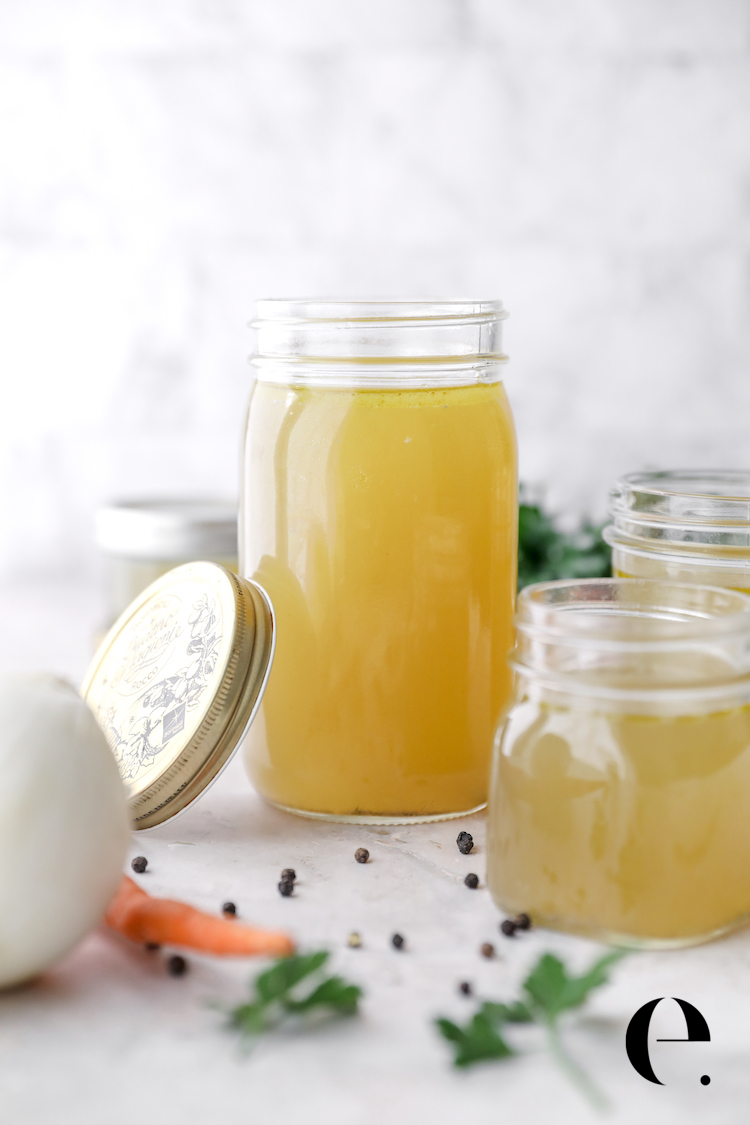

This is hands-down the best homemade chicken stock recipe!
This is my mom’s chicken stock recipe. She made it almost every weekend in the cold months when I was growing up. I’ve tried variations, but I always come back to this tried-and-true classic chicken stock recipe.
There’s a reason chicken stock is the base of so many soups and sauces—it has a delicious savory flavor and is incredibly nutritious. It’s used frequently in healthy soup recipes, gravy, and pan sauces, and more.
Just like homemade veggie stock from scratch and other stock recipes, you can genuinely tell the difference between homemade and store-bought chicken stock.
I’m giving you a lot of details here so you can use what you have on hand and make different variations of homemade stock, so read the details, then go make the best homemade chicken stock of your life!
Basic Chicken Stock from Scratch
The basic chicken stock recipe from scratch is as simple as gently simmering a handful of wholesome ingredients for 4–12 hours. Here’s what you’ll need:
- Chicken Parts: Use the leftover carcass from a roasted chicken, any bones, skin, or scraps from a whole chicken or parts.
- Vegetables: A classic trio of carrot, celery, and onion (no need to be fancy—roughly chop them).
- Herbs & Spices: These aromatics—like bay leaves, parsley, thyme, or a sprig of dill—add depth to your stock.
- Peppercorns: A few whole peppercorns for subtle spice.
- Optional: Add a splash of vinegar to help extract minerals from the bones (see below for details of why vinegar might be a key ingredient in your chicken stock).
Simmer low and slow, and let the magic happen as the flavors meld into a rich, nourishing broth that’s perfect as a base for soups, sauces, or sipping on its own.
The stock will develop part of its nutrition profile from the veggies and aromatics, but the most significant healing factor in stock is the minerals, collagen, and gelatin extracted from the chicken bones while they simmer.
Why add vinegar to chicken stock? Adding some vinegar (for its acidic quality) to your stock recipe helps extract more collagen protein from the bones. If you simmer chicken stock long enough with a little vinegar, you’re making homemade bone broth. You can’t taste the vinegar; it’s simply there to aid in extracting the collagen from the bones. Lemon works too but becomes bitter when simmered too long, so I save my lemon to garnish (it’s beautiful in stock!) so it doesn’t get overcooked.
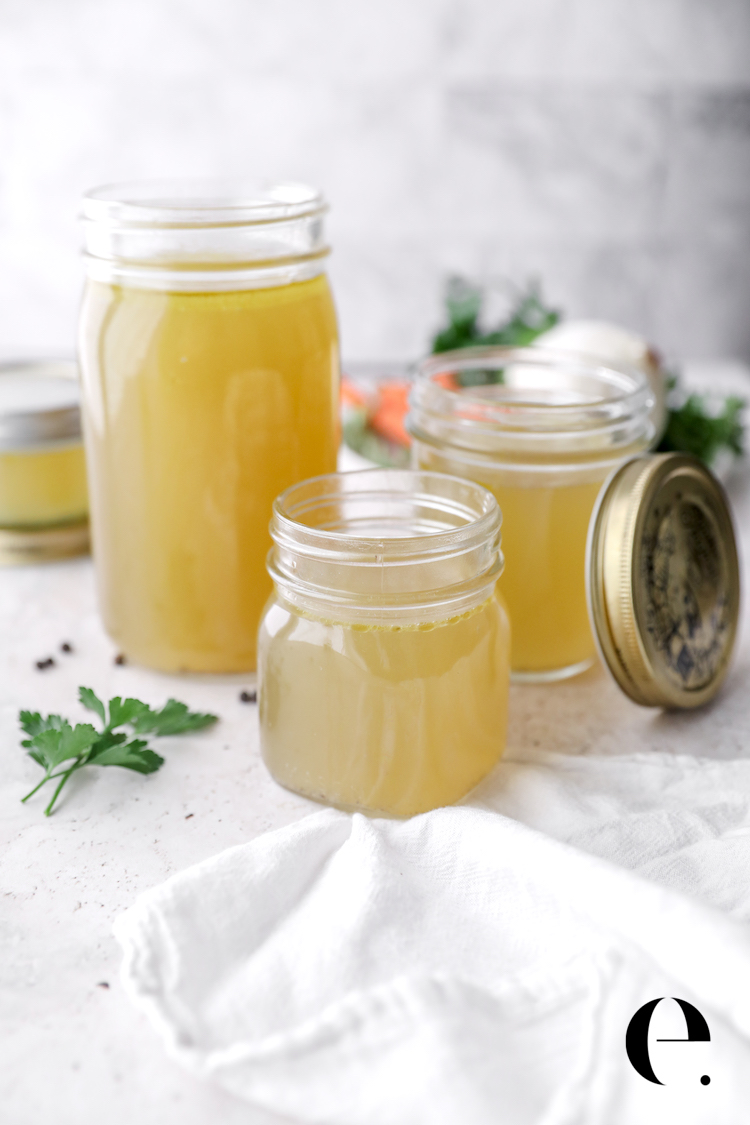
Use a Whole Chicken or Chicken Parts
There are a few options for the chicken base of your stock.
- A whole raw chicken: The chicken stock recipe in the printable recipe carb below uses a whole chicken. You can use the leftover meat in another dish, like chicken noodle soup, chicken salad, or chicken lettuce wraps.
- Chicken carcass from roasting a whole bird: You can make this recipe with any leftover bones or the whole chicken carcass after you roast a whole chicken (or turkey for turkey stock). When you roast a chicken or turkey, remove all of the meat, then use the leftover bones & skin (the entire carcass) in your stock.
- Individual pieces: If you roast individual bone-in chicken pieces like bone-in chicken breasts, whole legs, wings and/or thighs, use the meat and put all of the bones and skin leftover into the pot with your vegetables and aromatics.
This chicken stock recipe is beyond simple, even for first-timers! The prep time is minimal and your chicken stock can just simmer away while you prepare other food or go on with your day (or even while you sleep).
Vegetables in Chicken Stock
The main veggies in traditional chicken stock are:
- white or yellow onion
- carrots
- celery
The main aromatics are:
- whole peppercorns
- bay leaf
- herbs like thyme, parsley and/or dill
- sometimes whole garlic cloves
Other additions can include fennel bulb, whole garlic cloves, and mushroom stems to enrich your broth. Some people add rosemary, but many chefs and home cooks (including me!!) find rosemary to be way too strong in stock. I love rosemary in crackers or other dishes, just not in stock. It’s too overpowering.
Fennel will add an anise flavor to your stock so only use that if you love the taste of fennel. Garlic can be a nice addition to your stock, just be mindful that whatever you use your stock for will have a garlicky flavor. Mushroom stems leftover from mushrooms in another recipe will add a nice umami richness to your stock.
Fresh vs Dried Spices? I always like to use a dried bay leaf and fresh parsley stems + fresh thyme in my stock. If you only have dried, use half the amount of dried spice if a recipe calls for a fresh herb.

The Difference Between Stock, Broth, & Bone Broth
Are chicken broth and chicken stock the same thing? Yes, pretty much. Chicken broth and chicken stock are essentially the same thing. If you ask 10 chefs what the difference between stock and broth is, you’ll probably get 10 different answers.
Chicken Stock vs Chicken Broth? For the sake of this post, I’m going to say that stock and broth are the same thing.
Just like stock and broth, there isn’t a strict definition between regular broth and bone broth. The most significant difference is probably the vinegar and the amount of time that you let it simmer.
You can make a wonderful stock in as little as 4-6 hours which is great for your health. To get the maximum benefit and flavor from the bones, simmer for at least 12-24 hours.
If you want to turn your chicken stock recipe into traditional bone broth, you should add as many extra bones as possible. Ask your butcher for any leftover bones (even chicken feet!) that they have behind the counter. Add a tablespoon of vinegar, then simmer for 12-24 hours.
How to Make Chicken Stock from a Whole Chicken or Chicken Parts
The printable version of this recipe is below.
Step 1: Get a Whole Chicken (or Chicken Parts)
I like to ask the butcher counter to remove the bag of organs for me since you don’t need that for your stock. Some people use it and that’s fine, but the organs can change the flavor so I don’t use them in this dish. If you keep the organs, cook them separately from your stock.
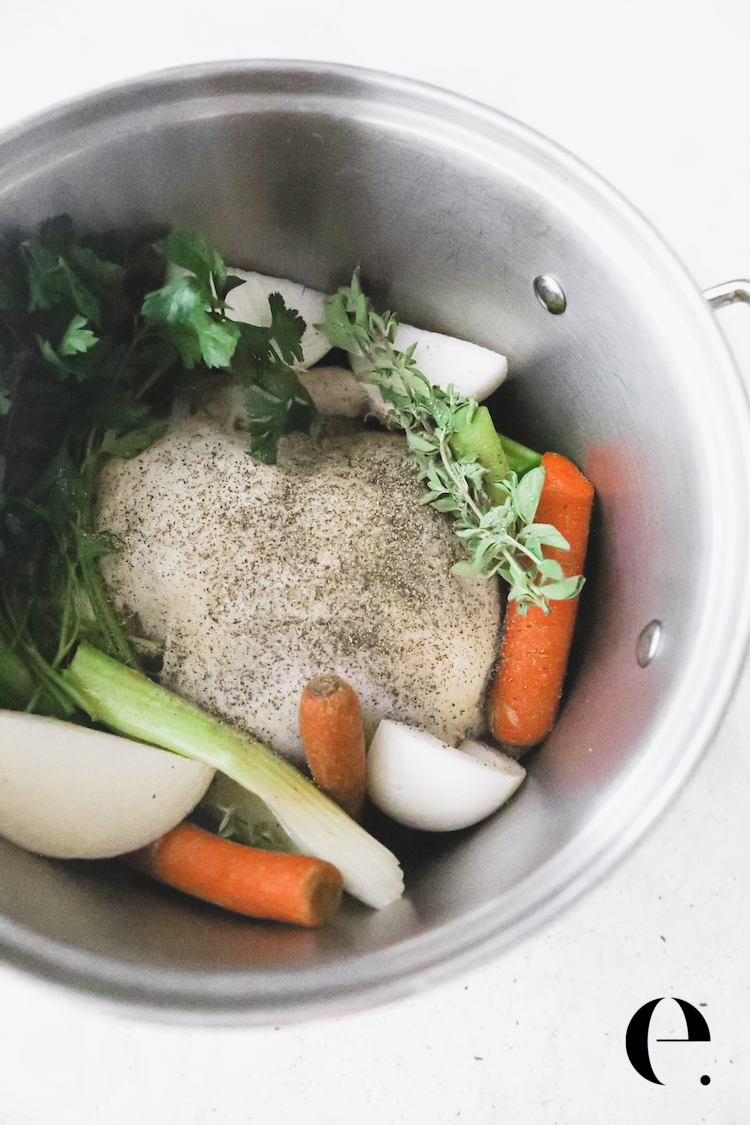
Step 2: Fill the Pot
In the largest pot you have (preferably at least 6 quarts), place the whole chicken (make sure there isn’t any paper in the cavity), the celery, carrot and onion, and aromatics (bay leaf, parsley, whole peppercorns) in the pot, then cover with water being sure to leave a few inches above the water so it doesn’t boil over. Consider adding 1 tablespoon of distilled white vinegar or apple cider vinegar to the pot to help draw out the collagen, but it’s ok to skip.
It will look something like this when you put it on the stove to come up to a simmer:
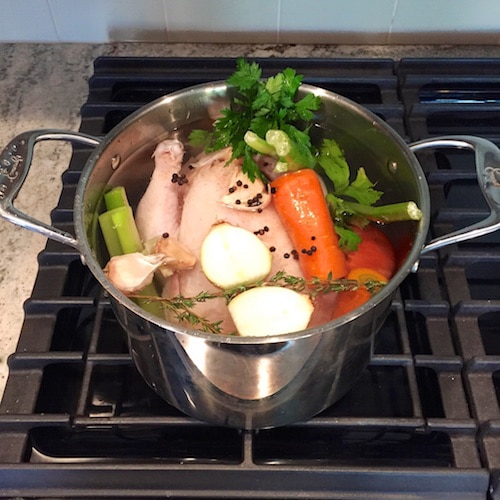
Again, you could also make this recipe using just the chicken bones (with the meat removed) after roasting a whole chicken or pieces of chicken.
If you ever roast a whole chicken or turkey, simply use whatever is left from the whole chicken after removing the meat (bones, skin, and juices all make great additions to your stock)!
3. Bring to a Boil, Reduce to Simmer
Set it on the stove, bring to a boil, then reduce the heat to a simmer. Allow it to simmer for at least 4 and up to 24 hours.
*If you use a whole chicken, remove the meat from the chicken after about 2 hours (once it’s cooked through) to prevent overcooking it. After you remove the meat—be sure to get all of the breast meat, leg meat, and thigh meat—put everything back in the pot to continue cooking the stock.
To remove the meat from the whole chicken, follow these steps:
- Carefully remove the whole chicken from the pot and set it on a large cutting board. It will be very hot, so let it cool a bit before you handle it.
- Use two forks or a knife to remove as much of the cooked chicken meat as possible. The meat will be nicely poached. You can shred it or just cut it up.
- Put the meat in an airtight glass container. Let it come to room temperature before storing it in the refrigerator, where you can keep it for up to three days. You can also use it right away after your stock is done if making soup.
- BE SURE to place all of the bones, skin, juices, and everything else back into the pot after removing the meat to continue making chicken stock.
Let it simmer for at least another 2 hours, or up to 24 hours. The longer you simmer the stock, the more flavorful and nutritious it will be.
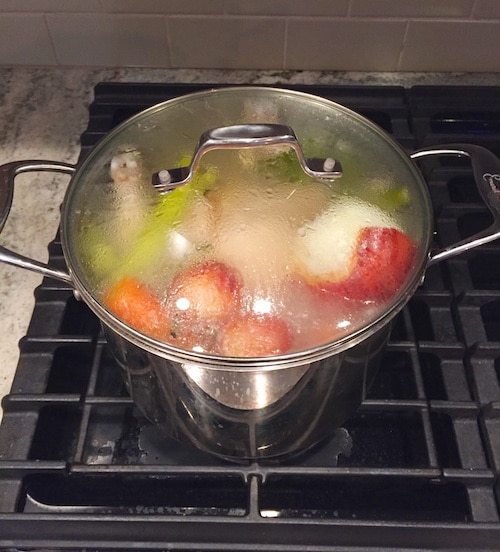

Step 4: Simmer 4-24 Hours, Then Strain
Keep the pot covered with a lid while it simmers to prevent your stock from evaporating. If you notice the liquid reducing too much, you can add a few cups of water at any time during the process.
After simmering for at least 4-6 hours in total, strain your stock through a fine-mesh strainer, colander, or cheesecloth into a large bowl or pot. I try to simmer mine at least 6 hours.
Discard everything that was in the pot except the liquid you just strained. The veggies, herbs, and bones are no longer usable for other recipes (they should be really soggy and cooked down—they’ve served their purpose!).
Ladle into soup bowls or mugs or store in freezer-safe containers and enjoy for months!
Chicken Stock in a CrockPot
CrockPot owners, rejoice! You can follow the above directions but use a slow-cooker (aka Crockpot) instead.
- Add all of the ingredients and water to your CrockPot.
- Turn the heat to high until it comes to a simmer—probably about 2 hours. It will take a while to simmer, as the slow-cooker heats at a slower pace than your stovetop.
- Remove the meat once it’s cooked through, roughly 2.5-3.5 hours in. (Skip this if using chicken parts or a chicken carcass.)
- Add everything back in just like the method above. Let it all simmer on LOW for 4-24 hours.
- Keep it covered and let it simmer as long as you’d like. You may want to add another cup or two of filtered water if too much liquid evaporates.
All slow-cookers are different. You may want to leave it on high if it’s not gently simmering on low. I leave mine on low overnight after being set on high for about 3 hours and put it on low evernight.
To store, let it come to room temperature. Then store in quart containers in the refrigerator for up to 3 days or in the freezer for up to 6 months.
If freezing, freeze in portions that will be useful to use in recipes, like 2-cup (1-pint) or 4-cup (1-quart) containers.
Chicken Stock in an Instant Pot
Yes, you can make chicken stock in a pressure cooker like an Instant Pot. To do it:
- Place all of the ingredients in your instant pot and fill with enough water to just cover everything, being sure not to fill the pressure cooker more than about 2/3 full (a pressure cooker can’t come up to pressure if it’s too full). That means you may have to reduce the ingredients or cut the chicken parts in half if you had a big chicken.
- Set to pressure cook on high for 40 minutes.
- It will take about 20 minutes to come up to pressure, and do a natural release for 30 minutes. All in, it will take about 90-100 minutes to make chicken stock in a pressure cooker.
Description
This chicken stock recipe was a staple in my home growing up. I remember my mom making chicken stock on the stove every weekend, all winter long. Use it as the base of soups, stews, gravies, or sauces, or sip it plain for a nourishing, savory treat.
- Place a 6- to 8-quart pot with a tight-fitting lid on the stovetop. I use a 6-quart pot for a 4- or 5-pound chicken.
- Remove the paper pouch that contains the organs if it’s still in the chicken. Use in another recipe or discard.
- Add all ingredients to the pot. Clean the veggies but it’s ok to leave the skin on the onion and carrots. Cover with filtered cold water to about an inch below the top.
- Put a tight-fitting lid on the pot.
- Set it on the stove and bring it to a boil. This takes about 10-20 minutes.
- Immediately reduce to a simmer. Simmer for at least 4 hours or up to 24 hours. The longer the simmer, the better the flavor.
- If you use a whole chicken, remove the meat from the chicken after 2 hours to prevent overcooking it. (See the sections above for my method to remove the meat).
- Keep the pot covered to prevent your stock from evaporating. If you notice the liquid reducing too much, you can add a few cups of water at any time during the process.
- After simmering for at least 4 hours in total, strain your stock through a fine-mesh sieve, strainer, or cheesecloth into a large bowl, pot, or a large stockpot. Simmer up to 24 hours for more flavor before straining.
- Discard everything that was in the pot except the liquid you just strained. The veggies, for example, are beyond saving, but they served a very good purpose.
CrockPot Method:
- Follow the above directions, but use a slow cooker instead. Add all of the ingredients and water to your slow-cooker.
- Turn on high heat until it comes to a simmer—probably about 2 hours. It will take a while to simmer as the slow-cooker heats at a slower pace than your stovetop.
- Remove the meat once it’s cooked through, roughly 2-3 hours in.
- Add everything back in just like the method above. Let it all simmer on low for 4-24 hours.
- Just keep it covered and let it simmer as long as you’d like. You may want to add another cup or two of filtered water if too much liquid evaporates.
All slow-cookers are different. You may want to leave it on high if it’s not gently simmering on low. I leave mine on low overnight after setting it on high for about 3 hours, and it simmers all night. (The house smells fantastic in the morning!)
InstantPot Method:
- Place all of the ingredients in your instant pot and fill with enough water to just cover everything, being sure not to fill the pressure cooker more than about 2/3 full (a pressure cooker can’t come up to pressure if it’s too full). That means you may have to reduce the ingredients or cut the chicken parts in half if you had a big chicken.
- Set to pressure cook on high for 40 minutes.
- It will take about 20 minutes to come up to pressure, and do a natural release for 30 minutes. All in, it will take about 90-100 minutes to make chicken stock in a pressure cooker.
Notes
- This method uses a whole chicken. You can also use this recipe with just the chicken bones, skin, and whole carcass of a roasted chicken.
- Use your stock right away to make homemade chicken soup or any other delicious recipe. It’s also great to sip plain in a mug with a big pinch of sea salt.
- To store, let it come to room temperature, then store it in quart containers. You can refrigerate it for up to 3 days or freeze it for up to 6 months.
- If freezing, store the chicken stock in portions that will be useful in recipes, like 2-cup or 4-cup containers.
Chicken Stock FAQ
Can I use a rotisserie chicken to make chicken stock?
I don’t recommend it. For one, the bones on a rotisserie chicken are really small. But the bigger issue is that it is coated in oil (probably an unhealthy oil) and seasoning (which probably has anti-caking agents and other things that don’t go well in stock. Chicken stock is best made with raw chicken or the extra bones and skin of a chicken that you’ve roasted at home. That said if there is a lot of oil left on a chicken you roasted at home, rinse it off with water as best as possible before using it in stock.
Is it better to use raw chicken or roasted chicken for stock?
Both make for a great stock. Using a whole raw chicken or raw parts is sometimes easier and faster and can yield a great stock. Some people say that the bones from a roasted chicken make for a deeper flavor, but I don’t think it’s hugely noticeable. I like like to make stock as it fits into my meal plans. If I roast a whole chicken for dinner, I use the leftover bones for stock. If I want to make chicken soup from scratch and I don’t have stock, I’ll use a whole raw chicken. See the chicken soup video above to see the whole process.
How long should I simmer chicken stock?
I think 4 hours minimum can give your chicken stock a good flavor if you want to make soup and need it more quickly. If I make it on the stove, I let it simmer 4-8 hours. I almost always let it simmer 24 hours if I use a CrockPot. I’ve even started it on the stove and moved it to a CrockPot, though, I don’t do that often because it creates more dishes than necessary.
Chicken Stock Recipe Suggestions
What can I use chicken stock for? You can use chicken stock for hundreds of delicious recipes, including:
Pin It!






